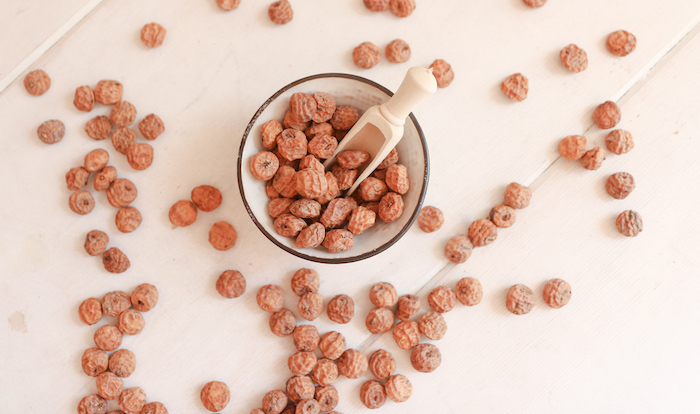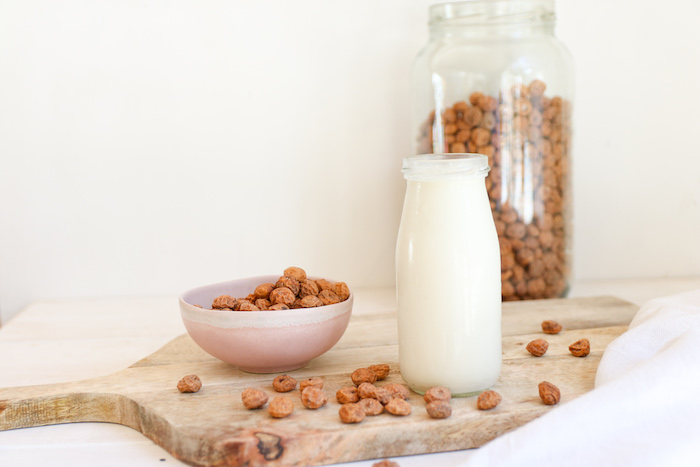If you like to prepare your own plant milk, then this tiger nut milk should not be missing in your repertoire. Besides taste and wholesomeness, there’s a lot to tell about tiger nuts.
But what are they?
Tiger nuts are actually not nuts at all. They grow underground as pea-sized, brown nodules on the roots of the tiger nut plant (Cyperus esculentus). Cyprus grass belongs to the sour grass family and is cultivated in Europe, especially in Spain in the Valencia area. The sandy, loose soils and mild climate there are ideal for growth.
The small, sweet-tasting root tubers, called chufas in Spain, are dried and sold whole, as tiger nut flakes or as tiger nut flour.

Tiger nuts have a very balanced nutrient profile. They contain an abundance of vitamins C and E, the minerals phosphorus, magnesium, potassium, calcium and iron and are very rich in fiber.
Tiger nuts are well tolerated by people with nut allergies, histamine intolerance and fructose malabsorption. They’re alkaline metabolized and are gluten and lactose free.
Tiger nut milk is prepared in a flash and doesn’t need extra sweetening because of its natural sweetness.
TIGER NUT MILK
INGREDIENTS
- 1 cup tiger nuts
- 3 cups water
PREPARATION
- Soak tiger nuts in cold water for at least 8 hours – preferably overnight.
- In the morning, drain, rinse and blend with fresh water in a high-powered blender on high speed for 30 seconds.
- Pour the mixture through a nut bag and squeeze thoroughly with your hands.
- Kept in a glass bottle, tiger nut milk can be stored in the refrigerator for 2 – 3 days.

Tiger nuts are rich in dietary fiber
Their high content of soluble and insoluble dietary fibers is remarkable. Let’s take a closer look at the health effects of dietary fiber.
Soluble dietary fiber
Water-soluble dietary fibers such as pectin and inulin bind water in the large intestine and swell. In this way, they increase stool volume and stimulate intestinal motility.
In addition, water-soluble dietary fibers serve as food for intestinal bacteria and promote healthy intestinal flora. During metabolism, short-chain fatty acids are formed. Here, butyric acid (butyrate) in particular has become the focus of recent research. These short-chain fatty acids nourish the intestinal mucosa and stabilize its barrier function, strengthen immune defense, reduce inflammatory reactions in the body and play a role in regulating blood sugar levels.
Insoluble dietary fiber
Insoluble dietary fibers, like soluble dietary fibers, enter the large intestine intact. Here, also like soluble fiber, they bind water, contribute to an increase in stool volume and activate intestinal peristalsis.
With the preparation of tiger nut milk, we separate most of the dietary fiber as pomace in the nut milk bag. But this pomace doesn’t have to be discarded. We can dry it, grind it into flour and process it for further uses, for example in the Poppy Seed Apple Roll.
Would you like to join our unique, based on nutritional sciences and practice-oriented training program for gaining a high level of health?
We are more than happy to inform you about our training program on our website!



0 Comments